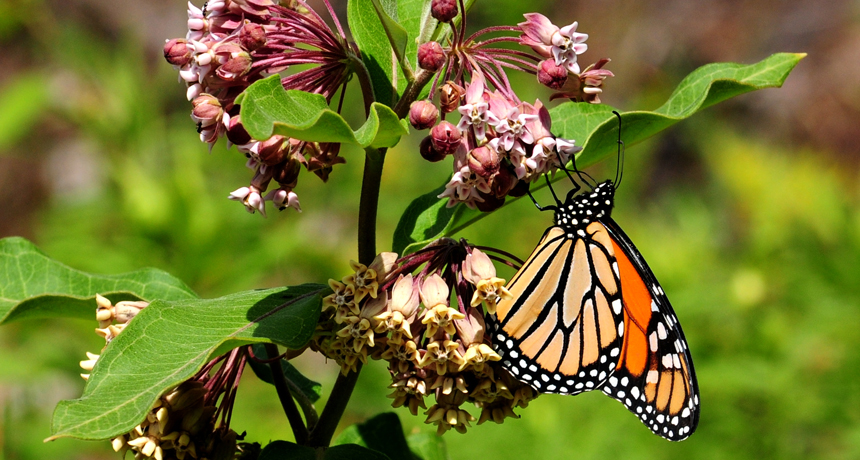Winter road salting reshapes next summer’s butterflies
Anti-ice treatments can have sex-specific effects

SALTED Monarch butterflies that weren’t even alive during the winter can show the physiological effects of road salting if caterpillars fed on milkweeds that picked up extra sodium.
Seney Natural History Association/Flickr (CC BY-SA 2.0)
Salting roads in winter can tweak the physiques of butterflies the next summer.
Milkweeds and oaks, plants that caterpillars graze on, collected from alongside a country road carried higher sodium concentrations than the same species growing at least 100 meters from the splash and drift of deicing salt, says Emilie Snell-Rood of the University of Minnesota in St. Paul.
Monarch (Danaus plexippus) caterpillars raised on the sodium-boosted plants turned into males with extra thoracic muscles and females with bigger eyes and probably bigger brains than butterflies reared on the more distant foliage, Snell-Rood and her colleagues found. A different butterfly, the cabbage white, echoed these his-and-hers effects when reared on a sodium-boosted lab diet, researchers report June 9 in the Proceedings of the National Academy of Sciences.
So is road salt good for butterflies? “I do not want that to be the take-home message,” Snell-Rood says. Instead, she says, the study demonstrates for the first time that road salt can alter how animals develop physically. But too little is known yet to judge the end effect of those alterations. Her back-roads results, for example, might not apply in the supersalted zones of bigger highways.
“I see this paper as both exciting and worrying,” says Nathan Morehouse of the University of Pittsburgh, who has studied diet’s effects on butterflies. “This really opens up a broader palette of human influences than we typically consider important, at least for animal nutrition.”
People may obsess about eating less sodium, but for many animals it’s a precious micronutrient in short supply. “It’s driven the evolution of really weird foraging behaviors” such as eating dirt, Snell-Rood says. Butterflies crowding to sip from puddles or alighting on another animal’s face to drink tears may be feasting on sodium (SN Online: 5/1/14).
The idea of studying the effects of road salt on butterflies started growing when Snell-Rood moved to Minnesota in 2011. Earlier research on road salt had focused on different issues, including work suggesting that the roadside sodium bonanza affects ant foraging and draws moose nearer to highways, an unfortunate development if the salty foliage lures more moose to bumble into cars.
How much, if any, road salt sodium ends up in plant tissues varies massively by species, Snell-Rood found. A kind of panic grass and a wild mustard called hoary alyssum didn’t appear to pick up any extra sodium, but roadside Northern pin oaks had about 50 percent more sodium than distant oaks, and milkweeds, the main food for monarch butterfly caterpillars, could carry 30 times as much sodium.
The plants’ leaves were also dosed and begrimed with other substances that splashed, seeped or blew off the roads. To isolate effects of the salt, Snell-Rood and colleagues followed up their monarch study with a test of cabbage white butterflies (Pieris rapae), which cooperate in the lab by growing on a highly controllable diet. Changing sodium alone in the diet produced the same kinds of effects that the researchers had seen in the monarchs. At a sodium dosage of about 3,000 parts per million, about mid-range for what caterpillars encounter in wild landscapes, males among the cabbage whites matured into butterflies with about 8 percent more thoracic protein (indicating some more muscle) than their counterparts raised at the low end of wild sodium concentrations, about 400 ppm. And the female cabbage whites raised on more sodium had about 20 percent bigger brains.
Sex differences in the results surprised Morehouse, who is working with Snell-Rood on another project and was not involved in the new study. But the butterfly sex differences may reflect the divergent priorities of the sexes. Male monarchs and cabbage whites both vie for mates in what’s called scramble competition, essentially a free-for-all race among males. Stronger thoracic muscles could mean males can outfly the competition.
Females’ priority, Snell-Rood says, is finding quality host plants for laying eggs. A butterfly’s brain is about 75 percent devoted to vision, so bigger brains may improve butterfly botanizing.
Snell-Rood had tried to investigate effects of higher plant sodium concentrations, but the insects did not survive well enough. And even for modest levels, the long-term effects are “very poorly understood,” says Stuart Findlay of the Cary Institute of Ecosystem Studies in Millbrook, N.Y. Overall, the biggest question about road salt chemicals, he says, is their persistence.






